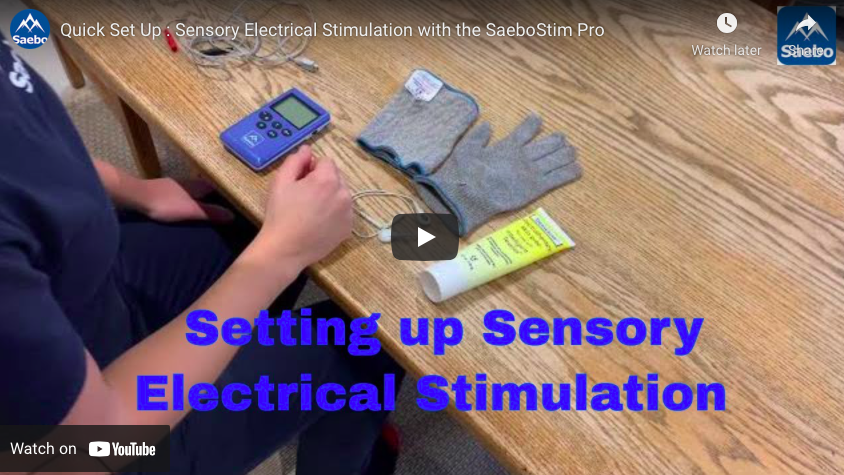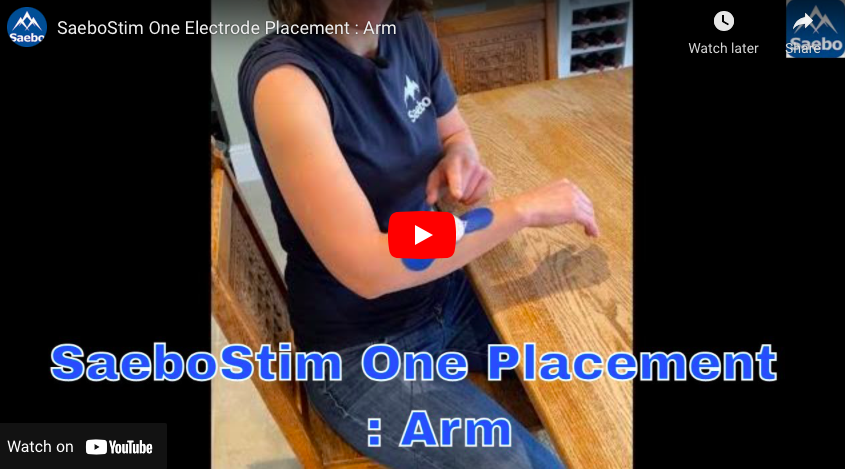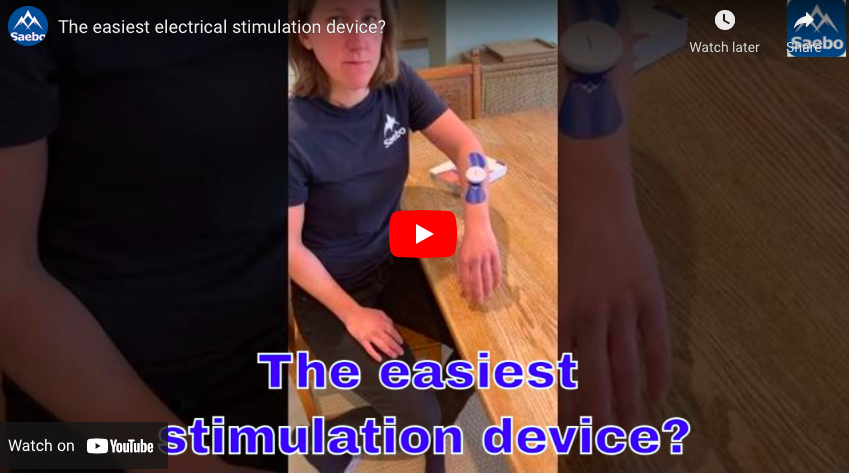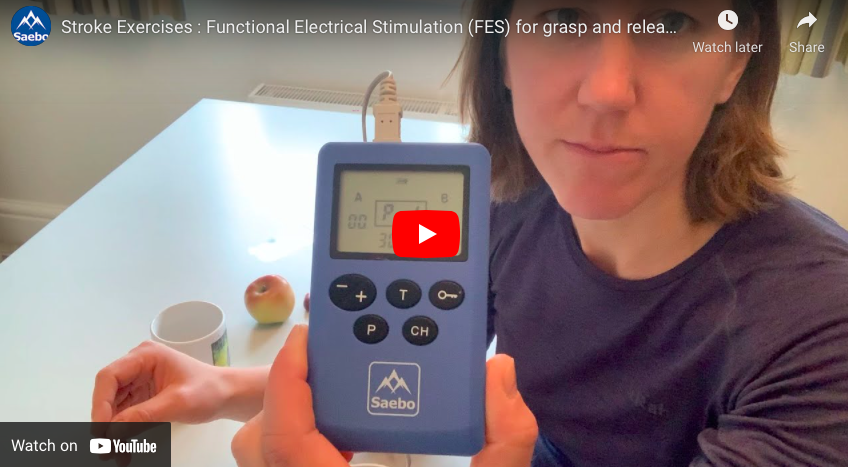Demystifying Electrical Stimulation a REPOST FROM AMY BEAN SAEBO UK
Demystifying Electrical Stimulation
Amy Bean
Friday, May 1st, 2020
My advice to you is to read through this article, get a better understanding of EMS, or Electrical Muscle Stimulation, the benefits, precautions, and if you live in Canada, there is information at the end of this article that can help you if you suffered a Neurological injury such as a Stroke, ABI, TBI, or you are living with MS or ALS.

In the most simplest terms, electrical stimulation is the sending of an electrical impulse from a device, usually via surface electrodes stuck to the skin, to a nerve. These electrical impulses can be used to generate muscle contractions, modulate nerves to reduce pain or provide a low level sensory stimulation.
Sensory Electrical Stimulation (SES)
Sensory electrical stimulation is a low level stimulation that stimulates sensory neurons. As muscle neurons are not stimulated, no muscle contraction occurs. The stimulation is usually administered sub-sensory threshold i.e. the user doesn’t feel anything.
By providing low level SES, studies have shown that it improves excitability in the brain which can in turn lead to improved motor recovery after a neurological injury (Golaszewski et al 2012). Particularly for people who have little or no movement in their arm after a neurological injury it is a relatively easy way of providing much needed input to the arm.
Potential Benefits
- Reduced spasticity (Seib et al 1994)
- Improved sensation (Vallar et al 1996)
- Improved motor function (Laufer 2011)
How is it administered?
SES can be delivered via electro mesh garments or gel electrodes depending on which device you are using. These are applied to the body area that is being targeted. The benefit of mesh garments is they provide a wider distribution of the stimulation compared to electrodes.
In the UK it can be self administered and our Clinical Specialist shows you how in the video below. Although a therapist is not required, if you have any queries about suitability and application you may wish to seek advice from a therapist if you have access to one; alternatively you can contact our Clinical Team here at Saebo UK.
Who can use it?
- Anyone with impaired sensation, increased spasticity or reduced motor function after a neurological injury.
- It can also help with pain and neuropathy for some users.
- Anyone wishing to use our SaeboStim Pro with Sensory Accessory Kit can seek advice from our Clinical Team at Saebo UK.
- If you have certain medical conditions, it may not be safe to use – see the Contraindications section at the end of this blog.
TENS (Transcutaneous Electrical Nerve Stimulation)
TENS is electrical stimulation for pain relief. It works by activating either the pain gate mechanism (blocking the pain signals to the brain) or stimulating the opiod system for our body’s own pain relief. Different parameters on a TENS device account for the different ways it can be used to provide pain relief.
The effectiveness of TENS is varied, but research shows it can be used on acute or chronic (early and long term) conditions and both musculo-skeletal and neurological in origin.
Our SaeboStim Pro has 3 different TENS programmes within the 15 pre set programmes.
To learn which of the 3 TENS programmes is right for you and more detailed information on how they help with pain, read our TENS for Pain Relief blog.
NMES (Neuromuscular Electrical Stimulation)
NMES, sometimes called E-Stim or EMS (electrical muscle stimulation), is the delivery of electrical stimulation via surface electrodes to generate a muscle contraction. This is achieved by stimulating the peripheral nervous system (the system of nerves that branch out from the brain and spinal cord and extend to muscles and other organs). The electrical stimulation kickstarts the same sequence of events for a muscle to contract that has been impaired by the neurological injury.
Potential Benefits
- Increased muscle strength
- Increased range of movement of the muscle
- Reduced spasticity (Stein et al 2015)
A combination of the above can lead to improved function (Yang et al 2019)
How is it administered?
There are a variety of devices available to purchase online ranging in price and complexity. All devices ultimately are designed to achieve the same goal of a muscle contraction or sensory stimulation, therefore simplicity and ease of use is an important consideration when purchasing.
The electrical stimulation is delivered by surface electrodes that stick to the skin over the muscle. Guidance where to stick electrodes may either be in the device’s manual (as with our SaeboStim ONE ), via online resources such as our YouTube video or advice from a therapist.
It can be self administered, i.e. a therapist is not required.
There is some debate on how long it should be applied for but general consensus, based on research showing its effectiveness, is about 30 minutes per muscle group per day (Jae-Hyoung Lee et al 2017). The exception to this is shoulder subluxation which can be up to 6 hours per day (Faghri et al 1994).
It doesn’t need to be complicated as our Clinical Specialist shows you below with the SaeboStim One.
Who can use it?
Anyone with reduced strength, increased spasticity, reduced range of movement, or reduced motor function after a neurological or orthopaedic injury.
Certain medical conditions mean it is not safe to use : see contraindications section at the end of this blog.
FES (Functional Electrical Stimulation)
This is simply where NMES, which is described above, is used in a to practice a specific task. Examples would be reaching to grasp an object, sit to stand or walking. Watch our Clinical Specialist demonstrating grasping below
The method in which this is achieved can either be by working with the set on/off timing of the stimulation, using a trigger button on the device to control exactly when the stimulation comes on (e.g. SaeboStim Pro), or a movement sensor typically used with FES devices for foot drop to help with the walking.
Contraindications : medical conditions limiting safe use
Always check the device’s manual first or ask a health professional if you have access to one.
Generally agreed contraindications are :
- Pacemaker (you may be able to use if you have one and have sought approval from your GP or Consultant)
- Epilepsy, if uncontrolled and unmedicated.
- Pregnancy
- Metal implant where the electrodes are to be placed
If you are in any doubt about safe use, always seek professional advice.

THIS IS FOR CANADIANS.
This is great information, but what if you live in Canada, where you are unable to purchase the SaeboStim Pro, Sensory Accessory Kit, or SaeboStim One?
EMS or Electrical Muscle Stimulation does three main things.
1. Reduce Spasticity
2. Increase or Maintain Range Of Motion
3. Aid in Muscle Re-education
We have found these four options for Canadians:
1. Twin Stim - TENS & EMS Combo – JGH Rehab PRICE: $79.00
2. INTENSITY Twin Stim III TENS/EMS With Ac Power, Wall Plug / 9 V Batter – JGH Rehab PRICE $95.00
3. StimTec Plus TENS/EMS – JGH Rehab PRICE $149.00
4. Phase-5 TENS + EMS Combo – JGH Rehab PRICE $199.00
All four devices are both TENS and EMS, they just have different options and Price Points. We are offering 10% off these 4 devices until March 31st, 2024.
Simply use coupon code TENS/EMS. at checkout at JGH Rehabilitation & Consulting Services Ltd.
All content provided on this blog is for informational purposes only and is not intended to be a substitute for professional medical advice, diagnosis, or treatment. Always seek the advice of your physician or other qualified health providers with any questions you may have regarding a medical condition. If you think you may have a medical emergency, call your doctor or 911 immediately. Reliance on any information provided by the JGH Rehab website is solely at your own risk.




